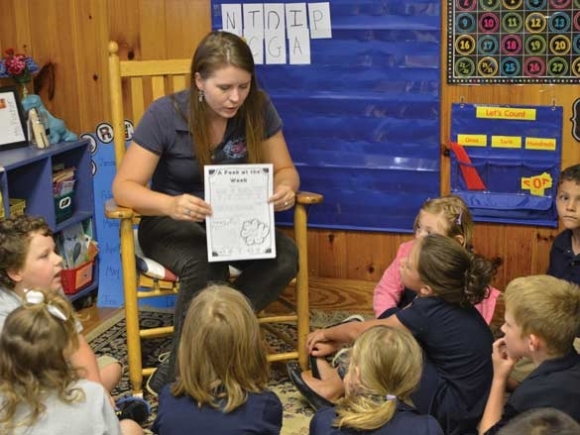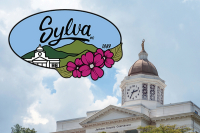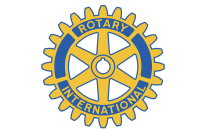SRCA discusses pros and cons of adding high school

Shining Rock Classical Academy leaders want to add high school grades to their growing charter school, but they’re just not sure now is the right time.
The SRCA board of directors held a public work session last week to hear from parents and discuss how the growth would impact the school financially and academically.
Parents’ plea
Several parents who spoke during the work session expressed support for expanding the K-8 charter to high school next year so that their children could continue at SRCA and graduate there eventually.
As a cafeteria worker in the Haywood County Schools system, SRCA mother Christy Stanley said she could see the difference in the behavior and success of the students attending the new charter school.
“We’ve got the best of the best — please have high school. My daughter wants to be first to walk across the stage at graduation,” she said.
Related Items
Marie Hicks, the parent of second-grader at SRCA, said her daughter now enjoys going to school every day.
“She’s changed so much since she started here and I would hate to see this end with eighth grade and have to put her in another setting. She’s so shy,” Hicks said. “If there’s anything I can do to help with high school just let me know.”
Alicia Koenighaus, parent of a third-grader, pleaded with the board to expand so she wouldn’t have to send her children to public schools that haven’t been a good environment for them.
“There’s no one that wants to go to high school more than people up here,” board member Jason Moody told the room full of parents and teachers. “But we have to do it in a manner that doesn’t draw from the rest of the school — if we get to a point we can do it with quality, then it’s a good decision.”
Financial risk
Financial constraints could slow down the process of adding high school grades at Shining Rock. The school’s K-8 modular-classroom campus is located on leased Lake Junaluska property on Dellwood Road, but there’s no more room there to expand to grades 9-12.
The board would have to find another piece of land to put modular classrooms or find a suitable building — but available land and facilities are hard to come by. It took SRCA more than a year to find a K-8 campus to settle into. Charter schools also don’t receive any capital funding from the state to help with facilities costs.
SRCA Board Treasurer Chad Carver said he ran some numbers trying to pinpoint what the school’s max budget would be for a high school facility. The good news, Carver said, is that SRCA started this school year with a $660,000 surplus in the bank and should have $850,000 at the end of this year thanks to conservative budget planning. The bad news is SRCA is repaying a $2.5 million loan — $14,000 a month — to Team CFA, a nonprofit that helps charter schools get started nationwide. The money was used to develop the Lake Junaluska site and purchase the modular buildings needed for classrooms. The school is also paying 7 percent interest for the nine-year term of the loan.
Even with the surplus, Carver said expanding to ninth grade next year could mean losing money.
“That’s what makes it difficult going forward,” Carver said. “We can spend $110,000 total (for facilities) to start high school next year, but we will be losing money for the next foreseeable future if we go to high school.”
That means SRCA would have to find land or a building option for less than $9,000 a month, which would be a challenge. And that’s just facilities — SRCA would then need to figure out how to pay for more teachers and support staff.
While Team CFA helps charters with start-up funds, SRCA Chairwoman Anna Eason said those funds have dried up and no more will be coming from the organization.
Academic impact
SRCA board members are also concerned expanding to high school too soon could compromise the rigorous academic standards the charter school currently strives for.
Terri Inman, a seventh- and eighth-grade language arts teacher, spoke up during the public comment portion of the meeting on behalf of the SRCA middle school team. She said the consensus among her teaching team was that they wanted to ensure the vision of the middle school program is solidified before the school decides to add high school to the mix.
“Core Knowledge doesn’t extend past eighth grade — it would have to be teacher-created curriculum. That’s a huge task for faculty to undertake,” Inman said. “We’re really stretched staff wise. I can’t see progressing without more specialists even in middle school.”
SRCA Director Ben Butler agreed that middle school would need more teaching specialists for next year. And if the board moves forward with creating a high school, a full-time person would be needed fairly quickly to begin developing a high school curriculum.
During SRCA’s first year in operation, 73 percent of the charter’s students achieved a passing score on the end-of-course testing and that percentage dropped to 62 percent during SRCA’s second year. School leaders say the quick growth from 226 students in its first year to 350 during its second year is a major reason why test scores were down. With the student population leveling off at around 400 this year, the board is hopeful those scores will begin to improve.
SRCA would also need to consider the possibility of losing students if the board decides to wait on adding high school grades. In a survey conducted among the parents of the 36 eighth-graders at SRCA, Eason said only three parents said they planned to place their child in another high school while the others are still hoping their child can continue at SRCA for high school.
“Usually it’s not the older kids you lose, it ends up being the younger kids leaving because parents want continuity,” Eason said.
The board didn’t make any decisions during the work session. The board’s next meeting will be held at 6:30 p.m. Sept. 20 at the Dellwood Road campus.
SRCA explores alternative high school option
Looking at the overwhelming costs associated with adding a high school campus to its K-8 charter school, Shining Rock Classical Academy Board Secretary Julia Bonomo presented the board with an outside-the-box idea for high school instruction.
In researching different kinds of high school charter schools, Bonomo said he was directed to look into the Summit Learning Platform.
“It’s a very intriguing instructional model which actually provides an online curriculum for schools but it’s not a 100 percent online experience,” she said.
The alternative learning model started in California and Washington about 10 years ago but has since been opened up to be used by public and charters all over the country. One charter high school in Durham that focuses heavily on STEM education — Research Triangle High School — has found the model to be highly successful and popular with students.
The entire curriculum is already established and is accessible through an online learning platform. Students are on a computer every day working their way through courses typical of any high school — English, math, science, history, and more.
“The courses are divided up into units so students are given a task and they choose how they want to learn the material,” Bonomo said. “The teacher only gets involved after the student reaches certain benchmarks.”
Since students have different learning styles, Bonomo said it made sense to let students decide how they would best learn the lesson whether it be through reading a series of articles, watching a documentary or conducting an interview with an expert through Skype.
When the teacher becomes involved, they help the students with further analysis of the subject through hands-on projects and experiential learning, which is already a key component in SRCA’s education model.
Using the Summit Learning Platform would also save SRCA time and resources.
It’s free and they provide teacher training for free,” Bonomo said.
She talked to the school director at Research Triangle High School and he invited the SRCA board to Durham to come check out how a classroom operates.
“He said it’s really an interesting program and students really like it because they’re in charge of how they learn it,” she said. “It also works well because you can have students in one class working at multiple speeds. Students struggling do well with this because they have a sense of mastery because they can’t move on unless they get 80 percent on a test.”
The courses are designed to march through high school and through AP levels as well. Teachers can also create their own courses within the online platform.
SRCA would still have to invest in new teachers and new computer technology if they used the Summit Learning Platform.
While it may seem completely different than many other instructional models, Bonomo said that could be a good thing.
“I don’t want to recreate a Shining Rock high school that looks exactly like the other two in town,” she said.
Students can access the platform at home too so even if they miss class they can keep up with their work.
Research Triangle High School as well as an impoverished North Charleston school using the model have seen amazing results, said Bonomo. Research Triangle is a high-performing school when it comes to test scores and the Charleston school’s graduation rate has gone from 50 percent to 75 percent, according to Bonomo.
“Durham does well on EOC testing and they don’t have to prep for it — it’s just based on their curriculum,” she said. “This would enable our students to be connected with a much larger world. We’d be teaching our students to be lifelong learners.”
— Jessi Stone, News Editor









